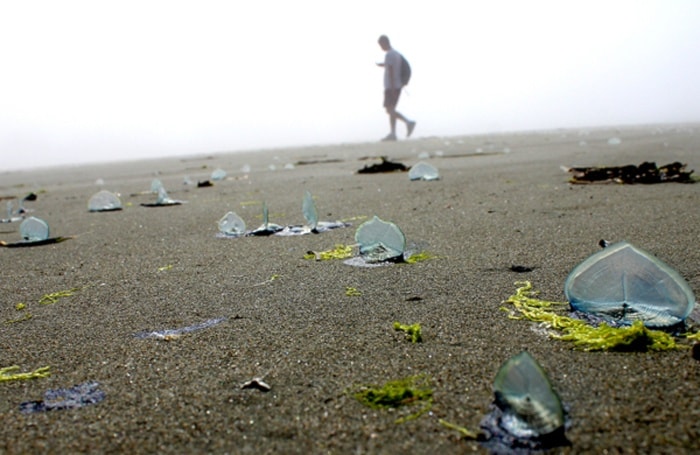Waves of Velella velella began crashing onto the West Coast's shores on Monday as Tofino's locals and visitors woke to find beaches covered in the small creatures.
Ucluelet Aquarium curator Laura Griffith-Cochrane had been out on the water the day before and does not believe the waves are over.
"I was out fishing on Sunday and it almost looked like there was a river of Velella velella in the water," she told the Westerly News on Wednesday. "There were sections of huge, huge, numbers of them seven miles offshore so I think there's still quite a few that will be coming this way."
She pointed to this year's consistently strong westerly winds and warm currents as the culprits and said the creatures are washing up along North America's entire western shoreline.
The sight of thousands of washed up Velella velalla is not uncommon to the West Coast as the phenomena occurs locally at least once every decade, according to Griffith-Cochrane who said the last mass-stranding occurred in 2010.
"It's one of those things that happens in a cycle," she said "It seems to happen in years that are a little bit warmer and it seems to happen in years when we have more consistent winds, but it does happen every four to ten years."
She said some Velella velella have been found along Ucluelet's Wild Pacific Trail but Ucluelet's coastline is rockier and more violent than Tofino's so the creatures often get broken apart rather than accumulate like they have on Tofino's Chesterman Beach.
She assured tourists and locals that it is still safe to walk barefoot in Tofino's sand as the animals are not harmful to humans.
"It would feel like you stepped on some soft plastic," she said.
Velella velella, also known as by-the-wind-sailors, are part of the hydrozoan family and can be found in oceans throughout the globe traveling by capturing wind in a sail made of flexible tissue, according to Griffith-Cochrane.
"The way that their sails are shaped is different throughout the oceans because of the prevailing winds," she said. "If you were to look at the ones here and then look at the shape of the sail in Aleutian Islands or close to Japan you would see a different pattern of sail shapes...Their body structure changes throughout the oceans."
They live in strictly structured colonies with each member playing its part.
"It's a really fascinating system, it's almost like an aquatic ant colony; there's some individuals that are intended for reproduction, some individuals have been specialized for prey capture, some individuals have been specialized for defense," Griffith-Cochrane said.
She said the colonies that have washed ashore will not survive and while this will not cripple the species, it could take a toll.
"Whenever there are mass-strandings like this it always affects the genetics of the population because there's a huge amount of adults that won't be able to continue through their life cycle," she said. "There will be thousands of individuals that won't be there to share their genetics so you can have a bit of a bottleneck effect where the total genetic population will then be altered...The surviving group will have a smaller arrangement of genetics to pass on to the next individuals...You can create evolutionary change in a fast timeline."
While the creatures are small, they play a large role in keeping oceans healthy by rotating nutrients.
"If there's a really big bloom in one area, and they develop really well close to that bloom, they'll eat all the little phytoplankton or tiny zooplankton and then, as they move to another area and poo, they distribute all of those nutrients from their initial meal to a new area so they're really important in nutrient cycling," Griffith-Cochrane said.
"Sometimes those species that come across as very simple actually provide the world with a huge amount of change."
